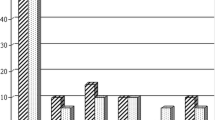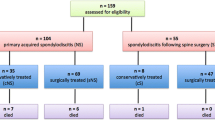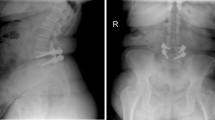Abstract
Cervical spine spondylodiscitis is a rare, but serious manifestation of spinal infection. We present a retrospective study of 20 consecutive patients between 01/1994 and 12/1999 treated because of cervical spondylodiscitis. Mean age at the time of treatment was 59.7 (range 34–81) years, nine of them female. In all cases, diagnosis had been established with a delay. All patients in this series underwent surgery such as radical debridement, decompression if necessary, autologous bone grafting and instrumentation. Surgery was indicated if a neurological deficit, symptoms of sepsis, epidural abscess formation with consecutive stenosis, instability or severe deformity were present. Postoperative antibiotic therapy was carried out for 8–12 weeks. Follow-up examinations were performed a mean of 37 (range 24–63) months after surgery. Healing of the inflammation was confirmed in all cases by laboratory, clinical and radiological parameters. Spondylodesis was controlled radiologically and could be achieved in all cases. One case showed a 15°kyphotic angle in the proximal adjacent segment. Spontaneous bony bridging of the proximal adjacent segment was observed in one patient. In the other cases the adjacent segments radiologically showed neither fusion nor infection related changes. Preoperative neurological deficits improved in all cases. Residual neurological deficits persisted in three of eight cases. The results indicate that spondylodiscitis in cervical spine should be treated early and aggressive to avoid local and systemic complications.




Similar content being viewed by others
Reference
Ditunno JF, Young W, Donovan WH, et al (1994) The international standards booklet for neurological and functional classification of spinal cord injury. Paraplegia 32:70–80
Endress C, Guyot DR, Fata J, Salciccioli G (1990) Cervical osteomyelitis due to IV heroin use: radiologic findings in 14 patient. AJR Am J Roentgenol 155: 333–335
Eysel P, Hopf C, Vogel I, et al (1997) Primary stable anterior instrumentation or dorsoventral spondylodesis in spondylodiscitis? Eur Spine J 6:152–157
Fayazi AH, Ludwig SC, Dabbah M, Bryan Butler R, Gelb DE (2004) Preliminary results of staged anterior debridement and reconstruction using titanium mesh cages in the treatment of thoracolumbar vertebral osteomyelitis. Spine J 4:388–295
Hadjipavlou AG, Mader JT, Necessary JT, et al (2000) Hematogenous pyogenic spinal infection and their surgical management. Spine 25:1668–1679
Harms J, Tabasso G (1999) Instrumented spinal surgery. Thieme, Stuttgart, New York
Heindel W, Lanfermann H, du Mesnil R, et al (1993) Infections of the cervical spine. Aktuelle Radiol 6:308–316
Hopf C, Meurer A, Eysel P, et al (1989) Operative treatment of spondylodiscitis—what is the most effective approach? Neurosurg Rev 21:217–225
Jeanneret B, Magerl F (1994) Treatment of osteomyelitis of the spine using percutaneous suction/irrigation and percutaneous external spinal fixation. J Spinal Disord 7:185–205
Klöckner C, Valencia R, Weber U (2001) Sagittal alignment following surgical therapy of destructive spondylodiscitis: ventral or ventrodorsal procedure—a comparison of results. Orthopade 30:965–976
Krödel A, Stürz H (1989) Differentiated surgical and conservative treatment of spondylitis and spondylodiscitis. Z Orthop Ihre Grenzgeb 127:589–596
Krödel A, Stürz H, Siebert CH (1991) Indications for and results of operative treatment of spondylitis and spondylodiscitis. Arch Orthop Trauma Surg 110:78–82
Lange M, Tiecks F, Schielke E, et al (1993) Diagnosis and results of different treatment regimes in patients with spinal abscesses. Acta Neurochir (Wien):105–114
Lewis M, Grundy D (1992) Vertebral osteomyelitis following manipulation of spondylitic necks—a possible risk. Paraplegia 30:788–790
Liebergall M, Chaimsky G, Lowe J, et al (1991) Pyogenic vertebral osteomyelitis with paralysis. Clin Orthop 269:142–150
Liljenqvist U, Lerner T, Bullmann V, Hackenberg L, Halm H, Winkelmann W (2003) Titanium cages in the surgical treatment of severe vertebral osteomyelitis. Eur Spine J 12:606–612
Malawsky SK, Lukawski S (1991) Pyogenic infections of the spine. Clin Orthop 272: 58–66
Maynard FM, Bracken MB, Creasey G, et al (1997) International standards for neurological and functional classification of spinal cord injury. Spinal Cord 35:266–274
Moser E (1989) Skeletal scintigraphic findings in spinal diseases. Radiologe 29:164–169
Przybylski GJ, Sharan AD (2001) Single-stage autogenous bone grafting and internal fixation in the surgical management of pyogenic discitis and vertebral osteomyelitis. J Neurosurg 94:1–7
Pszolla N, Strecker W, Hartwig E, et al (2000) Tuberculous spondylitis of the cervical spine. Unfallchirurg 103:322–325
Reihsaus E, Waldbauer H, Seeling W (2000) Spinal epidural abscess: a meta-analysis of 915 patients. Neurosurg Rev 232:175–204
Ruiz A, Post MJD, Ganz W (1995) Inflammatory and infectious processes of the cervical spine. Neuroimaging Clin N Am 5:401–425
Scale D, Schmit E, Jäger A (1994) Zum Korrekturverlust operativ behandelter HWS—Spondylitiden. In: Matzen K.A. Die operative Behandlung der Halswirbelsäule, M. Zuckschwerdt, 73–78, München
Schimmer RC, Jeanneret C, Nunley PC, Jeanneret B (2002) Osteomyelitis of the cervical spine. A potentially dramatic disease. J Spinal Disord Tech 15: 110–117
Schinkell C, Gottwald M, Andress HJ (2003) Surgical treatment of spondylodiscitis. Surg Infect 4: 387–391
Seifert V, Zimmermann M, Stolke D, et al (1993) Spondylectomy, microsurgical decompression and osteosynthesis in the treatment of complex disorders of the cervical spine. Acta Neurochir (Wien) 4:104–113
Shad A, Shariff S, Fairbank J, Byren L, Teddy PJMAD, Cadoux-Hudson TAD (2003) Internal fixation for osteomyelitis of the spine: the issue of persistence of culture positive infection around the implants. Acta Neurochir (Wien) 45:957–960
Sindern E, Gläser E, Bötel U, et al (1993) Spondylodiscitis with spinal and radicular deficits. Limits of conservative treatment. Nervenarzt 64:801–805
Spies EH, Stucker R, Reichelt A (1999) Conservative management of pyogenic osteomyelitis of the occipitocervical junction. Spine 24:818–822
Spuck S, Arnold H, Kranz R, Solbach W, Kaemmerer R (2005) Rapid manifestation of cervical vertebral osteomyelitis. Acta Neurochir (Wien) 147:671–673
Swanson AN, Pappou IP, Cammisa FP, Girardi FP 06) Chronic infections of the spine. Clin Orthop Relat Res 444:100–106
Tay BK, Deckey J, Hu SS (2002) Spinal infections. J Am Acad Orthop Surg 10:188–197
Turgut M (2001) Spinal tuberculosis (Pott’s disease): its clinical presentation, surgical management, and outcome. A survey study on 694 patients. Neurosurg Rev 24:8–13
Ulmar B, Richter K, Kelsch G, Cakir B, Puhl W, Huch K (2005) Distractible vertebral body replacement for the thoracic and lumbar spine. Acta Orthop Belg 71:467–471
Weber M, Heller KD, Wirtz D, et al (1998) Percutaneous CT-controlled puncture and drainage of spondylodiscitis—minimal invasive method. Z Orthop Ihre Grenzgeb 136:375–379
Author information
Authors and Affiliations
Corresponding author
Rights and permissions
About this article
Cite this article
Heyde, C.E., Boehm, H., El Saghir, H. et al. Surgical treatment of spondylodiscitis in the cervical spine: a minimum 2-year follow-up. Eur Spine J 15, 1380–1387 (2006). https://doi.org/10.1007/s00586-006-0191-z
Received:
Revised:
Accepted:
Published:
Issue Date:
DOI: https://doi.org/10.1007/s00586-006-0191-z




